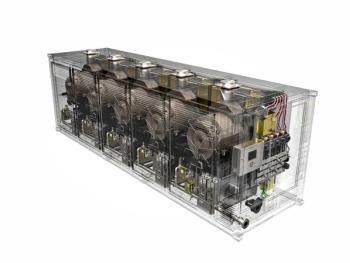
AUTOMATION UNLOCKS HIGHER PRODUCTIVITY
Scott Levy, Manager of Technology and Innovation at Regal Beloit Corp., discusses digital advances, automation, and where it is heading with its acquisition of Emerson’s Power Transmission Solutions business.[/caption]
How do you see digital advances helping to automate turbomachinery and make it more efficient?
The turbomachinery industry has come a long way from the run-to-fail maintenance strategy. With lateral vibration monitoring on critical equipment becoming more advanced, connected equipment can be shut down and processes halted without damaging the plant. The next frontier is having condition monitoring data to evaluate the efficiency of power transfer between the equipment and also to identify potentially damaging torque.
How should torque be addressed?
Torque monitoring has the potential to be as critical an instrumentation system as lateral vibration monitoring. Vibration monitoring has transitioned to become standard on virtually all turbomachinery equipment. As operational strategies have shifted from run-to-fail to predictive maintenance, new tools such as our Powerlign torque monitoring system allow for data-driven plant optimization. With tighter competition and contracting markets, single digit increases in efficiency can differentiate competitors. Leveraging accurate data points has been successfully utilized to optimize processes, verify machine performance, and plan downtime based on measured performance degradation. In the past, heat balance equations were used to determine efficiency of the connected equipment, but improved accuracy of these measurements is required to extract maximum performance. Powerlign has an error rate of less than 1%. This enables further enhancement of turbomachinery systems.
Why is automation lagging in turbomachinery?
We see a lot of automation in the commercial sector, but the turbomachinery industry is waiting to ensure security and reliability are adequate before the deployment rate increases. However, the direction is clearly headed towards automation tools. Recent cybersecurity initiatives by major OEMs are aimed at overcoming these obstacles and setting the stage for increased reliance on digital devices.
How are the latest automation techniques boosting productivity?
Automation is a key part our development process. We developed a Coupling Automation Program (CAP) tool which has improved our engineering process. Automation requires rules and consistency which translate into improved quality. This has benefits beyond engineering, as manufacturing and quality also take advantage of standardization.
How is this applied to your own products?
The original Kop-Flex disc coupling was designed more than 30 years ago using classic stress analysis equations and testing. Our newly launched High Performance Disc Coupling 2.0 product line was developed using finite element modelling. This was validated using a variety of tests performed with automated data collection. These methods have enabled fine tuning of the design, allowing us to tailor it to customer-specific application parameters. Detailed knowledge of applications also enables better product development. Components can be matched with actual conditions rather than estimates and predictions. The large safety factors dictated in industry specifications exist because of these uncertainties in applications and products. Reducing this through improved monitoring will continue to allow products to become more efficient while maintaining reliability.
How will this impact your products going forward?
We are embracing a future where monitoring and analytics are becoming more common. We have several internal product development initiatives focused on data acquisition of power, torque, speed, temperature and other variables, as well as analysis of these signals. Our goal is to utilize several data sources to provide our customers with robust data to make informed decisions about operation, maintenance, and capacity. Recently, we've also assisted customers with monitoring on test stands and equipment commissioning. These tests have been used to validate rotordynamic analysis, quantify actual performance, and increase confidence in the complete system.
How can Big Data best be harnessed?
More data is valuable but without providing analysis there isn't a value-add to customers and end users. The development of predictive analysis algorithms, however, expands existing tools beyond monitoring and allows integration into planning and control systems. Smart algorithms can locate a signal within all the noise and this is what will "crack the nut" on Big Data for the turbomachinery industry. It's not enough to just provide the data, we need to provide calculated recommendations and guidance on how they should act to enable better machinery health management.
How about integration between vendors and users?
As technology and software tools advance, integration with customers becomes more important to leverage data across businesses. iCAP, a web based high performance coupling product selection program, was launched in 2007. This Internet-based selection tool for couplings provides performance, basic data, and drawings that customers can leverage internally. Meantime, continued integration with turbomachinery OEM configuration and selection tools is an ongoing project. We provide links to our database from theirs to allow OEMs to design equipment more effectively from the start of the process rather than requiring modifications late in the cycle due to an unexpected design constraint. Finally, we are evaluating the use of electronics and software in a variety of areas. Training aids and catalogs are being deployed on tablets to allow quick reference. Power Transmission Solutions has released iPad apps in the App Store which we continue to expand. Additional opportunities exist to better support coupling installation and setup of monitoring and analysis tools.
Newsletter
Power your knowledge with the latest in turbine technology, engineering advances, and energy solutions—subscribe to Turbomachinery International today.




